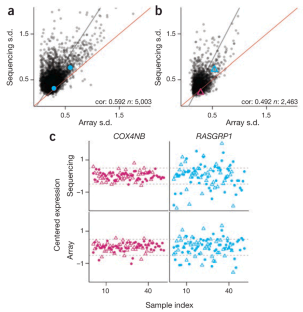Sequencing technology does not eliminate biological variability (original) (raw)
- Correspondence
- Published: 11 July 2011
Nature Biotechnology volume 29, pages 572–573 (2011)Cite this article
- 9339 Accesses
- 177 Citations
- 23 Altmetric
- Metrics details
Subjects
To the Editor:
RNA sequencing technology provides various advantages over DNA microarrays. For example, it is possible to measure alternative transcription1 or measure transcription for noncoding regions2 de novo. Another potential advantage is low technical variation2,3,4. This has led to rapid adoption of the technology and a recent surge of publications5. We would like to caution, however, that the euphoria surrounding the technology has led many of these publications to discount the influence of biological variability, forgetting perhaps that unwanted variability in gene expression measurements is not due only to measurement error. Gene expression is a stochastic process6 and is known to vary between units considered to be of the same population, for example, in samples from a specific healthy tissue across individuals7. In a typical experiment, variation in gene expression measurements [Var(Expr)] can be decomposed8 as the following:
This is a preview of subscription content, access via your institution
Relevant articles
Open Access articles citing this article.
Access options
Subscribe to this journal
Receive 12 print issues and online access
$209.00 per year
only $17.42 per issue
Buy this article
- Purchase on SpringerLink
- Instant access to full article PDF
Prices may be subject to local taxes which are calculated during checkout
Additional access options:
Figure 1: Biological variability measured with sequencing and microarrays.

References
- Wang, E.T. et al. Nature 456, 470–476 (2008).
Article CAS PubMed PubMed Central Google Scholar - Mortazavi, A., Williams, B.A., McCue, K., Schaeffer, L. & Wold, B. Nat. Methods 5, 621–628 (2008).
Article CAS PubMed Google Scholar - Bullard, J.H., Purdom, E., Hansen, K.D. & Dudoit, S. BMC Bioinformatics 11, 94 (2010).
Article PubMed PubMed Central Google Scholar - Marioni, J.C., Mason, C.E., Mane, S.M., Stephens, M. & Gilad, Y. Genome Res. 18, 1509–1517 (2008).
Article CAS PubMed PubMed Central Google Scholar - Wang, Z., Gerstein, M. & Snyder, M. Nat. Rev. Genet. 10, 57–63 (2009).
Article CAS PubMed PubMed Central Google Scholar - Elowitz, M.B., Levine, A.J., Siggia, E.D. & Swain, P.S. Science 297, 1183–1186 (2002).
Article CAS PubMed Google Scholar - Whitney, A.R. et al. Proc. Natl. Acad. Sci. USA 100, 1896–1901 (2003).
Article CAS PubMed PubMed Central Google Scholar - Churchill, G.A. Nat. Genet. 32 Suppl, 490–495 (2002).
Article CAS PubMed Google Scholar - Golub, T.R. et al. Science 286, 531–537 (1999).
Article CAS PubMed Google Scholar - Irizarry, R.A. et al. Nat. Methods 2, 345–350 (2005).
Article CAS PubMed Google Scholar - Shi, L. et al. Nat. Biotechnol. 24, 1151–1161 (2006).
Article CAS PubMed Google Scholar - Leek, J.T. et al. Nat. Rev. Genet. 11, 733–739 (2010).
Article CAS PubMed Google Scholar - Montgomery, S.B. et al. Nature 464, 773–777 (2010).
Article CAS PubMed Google Scholar - Pickrell, J.K. et al. Nature 464, 768–772 (2010).
Article CAS PubMed PubMed Central Google Scholar - Stranger, B.E. et al. Science 315, 848–853 (2007).
Article CAS PubMed PubMed Central Google Scholar - Choy, E. et al. PLoS Genet. 4, e1000287 (2008).
Article PubMed PubMed Central Google Scholar
Author information
Authors and Affiliations
- Department of Biostatistics, Johns Hopkins Bloomberg School of Public Health, Baltimore, Maryland, USA
Kasper D Hansen, Rafael A Irizarry & Jeffrey T Leek - Department of Community Health, Section of Biostatistics, Brown University, Providence, Rhode Island, USA
Zhijin Wu
Authors
- Kasper D Hansen
- Zhijin Wu
- Rafael A Irizarry
- Jeffrey T Leek
Corresponding authors
Correspondence toRafael A Irizarry or Jeffrey T Leek.
Ethics declarations
Competing interests
The authors declare no competing financial interests.
Supplementary information
Rights and permissions
About this article
Cite this article
Hansen, K., Wu, Z., Irizarry, R. et al. Sequencing technology does not eliminate biological variability.Nat Biotechnol 29, 572–573 (2011). https://doi.org/10.1038/nbt.1910
- Published: 11 July 2011
- Issue Date: July 2011
- DOI: https://doi.org/10.1038/nbt.1910